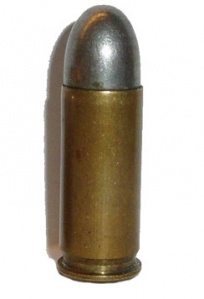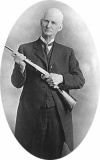Difference between revisions of ".38 ACP"
(Created page with '{{Cartridge |name= .38 Automatic Colt Pistol |image= 38 ACP.jpg |caption= |origin= USA |type= Pistol <!-- Specifications --> |parent= |case_type=Semi-rimmed, straight |b...') |
m (1 revision) |
Latest revision as of 14:23, 15 March 2013
| .38 Automatic Colt Pistol | ||||||||||||||||
|---|---|---|---|---|---|---|---|---|---|---|---|---|---|---|---|---|

| ||||||||||||||||
| Type | Pistol | |||||||||||||||
| Country of Origin | USA | |||||||||||||||
| Specifications | ||||||||||||||||
| Case Type | Semi-rimmed, straight | |||||||||||||||
| Bullet Ø | .356 in (9.0 mm) | |||||||||||||||
| Neck Ø | .384 in (9.8 mm) | |||||||||||||||
| Base Ø | .384 in (9.8 mm) | |||||||||||||||
| Rim Ø | .406 in (10.3 mm) | |||||||||||||||
| Rim Thickness | .050 in (1.3 mm) | |||||||||||||||
| Case Length | .900 in (22.9 mm) | |||||||||||||||
| Full Length | 1.280 in (32.5 mm) | |||||||||||||||
| Primer | small pistol | |||||||||||||||
| Production & Service | ||||||||||||||||
| Designer | John Browning | |||||||||||||||
| Design Date | 1900 | |||||||||||||||
| Manufacturer | Colt | |||||||||||||||
| Ballistic Performance Sampling | ||||||||||||||||
| ||||||||||||||||
The .38 ACP (Automatic Colt Pistol) also known as the .38 Auto was introduced at the turn of the 20th century for the Browning designed Colt M1900. The cartridge headspaces on the rim.[2] It had first been used in his Model 1897 prototype, which Colt did not produce. The metric designation for the round is 9x23mmSR (SR - Semi Rimmed) (not to be confused with the modern 9x23mm Winchester). It is not to be confused with the .380 ACP.
Contents |
[edit] History
Initial loadings of this cartridge were actually quite powerful. Reported ballistics for the first commercial loads were a 130-grain bullet at 1,260 fps, and some experimental loads ran as high as 1,350 fps.[2] However, these ballistics proved too violent for the Colt Model 1900 pistol, and velocities were soon lowered to below 1,200 fps. Subsequent commercial loadings varied considerably in power. For example, Captain Hugh B.C. Pollard, writing in Automatic Pistols published in 1920, gives Winchester factory ballistics as a 130-grain bullet at 1,175 fps for 398 foot pounds of muzzle energy; for Ely ammo, the figures were a 128-grain bullet at 1,100 fps and 344 foot-pounds and for Kynoch a 130-grain bullet at 1,000 fps. (Part of the reason for the disparity may have been the result of the fact that the Winchester ammo was tested from a 6-inch barreled Colt Model 1902 while the British loads were probably tested from the shorter-barreled Webley auto pistol in this caliber.) Later U.S. commercial loads in this caliber had factory standard ballistics of a 130-grain bullet at 1,040 fps from the 4.5-inch barrel of the Colt 1903 Pocket Model. The .38 ACP was jinxed by two factors: By the time the Colt autos in this caliber were introduced, Army Ordnance was already favoring a return to a .45 caliber sidearm, and the pistols themselves were soon rendered primitive and obsolescent in comparison to the Colt M1911. However, they did see small but steady sales up until the introduction of the more powerful .38 Super, which was little more than the .38 ACP loaded back to its original ballistics. In the interests of safety, American ammunition companies always loaded the original .38 ACP loads in brass cases, while .38 Super ammunition was loaded in nickel cases. Sales of .38 ACP ammo no doubt enjoyed a modest spike during the surplus gun boom of the 1950s and 1960s, since the cartridges would usually cycle in Spanish surplus pistols like the Astra 400 that were chambered for the 9mm Bergmann-Bayard (9mm Largo), despite the fact that the .38 ACP was semi-rimmed and a trifle shorter than the rimless 9mm Largo. Europe would eventually favor the 9 mm Parabellum cartridge developed from the 7.65 mm Parabellum. The Luger was ballistically similar to the .38 ACP but utilized a smaller case and higher pressures. Browning himself was not done with 9 mm cartridges and would soon introduce the 9 mm Browning Long (9x20mm) in 1903 and the .380 ACP (9x17mm Short) in 1908.[edit] .38 ACP pistols
- Colt M1900
- Colt M1902
- Colt M1903 Pocket Hammer
- Star Model AS
- Webley-Fosbery Automatic Revolver
- Webley Automatic Pistol
- M1911 pistol (civilian market)
[edit] Notes
Even though .38 ACP and .38 Super are the same size, it can be potentially dangerous to use .38 Super ammunition in a firearm intended for .38 ACP, as firearm damage may result.
There are over a dozen autoloading pistol cartridges, both semi-rimmed and rimless, in this caliber. Often, foreign or ambiguous headstamps make identification impossible. When in doubt, it is best not to fire suspicious cartridges in any firearm.
[edit] See also
[edit] References
[2] Article in April 19, 1900 issue of Shooting and Fishing, quoted in Belden, C.T and Haven, A History of the Colt Revolver (1940)
- ↑ Barnes, Frank C. (2006) [1965]. Skinner, Stan. ed. Cartridges of the World (11th Edition ed.). Iola, WI, USA: Gun Digest Books. pp. 328,338. ISBN 0-89689-297-2.
- ↑ Wilson, R. K. Textbook of Automatic Pistols, p.234. Plantersville, SC: Small Arms Technical Publishing Company, 1943.
[edit] External links
| This article is part of a series on the works of John Moses Browning | ||
|---|---|---|
| Semi-automatic pistols | FN M1900 · Colt M1900 · Colt M1902 · FN Model 1903 · M1903 Pocket Hammer · M1903 Pocket Hammerless · M1908 Vest Pocket · FN Model 1910 · M1911 · Colt Woodsman · Baby Browning · Hi-Power |  |
| Rifles | Winchester Model 1885 · Winchester Model 1886 · Winchester 1892 · Winchester Model 1894 · Winchester Model 1895 · Remington Model 8 · Remington Model 24 · FN Trombone | |
| Shotguns | Winchester Model 1887 · Winchester Model 1897 · Browning Auto-5/Remington Model 11 · Remington Model 17 · Savage Model 520 · Browning Superposed · Ithaca 37 | |
| Machine guns | Colt-Browning M1895 · Browning M1917 · Browning Automatic Rifle · Browning M1919 · M2 Machine Gun | |
| Cartridges | .25 ACP · .32 ACP · .38 ACP · .380 ACP · .45 ACP · .50 BMG | |
| This article is part of a series on .38 caliber goodies | |
|---|---|
| Cartridges | .38 Long Colt (1875) | .38 S&W (1877) | .38 ACP (1900) | .38 Special (1902) | .380 ACP (1908) | .38/200 (1922) | .38 Super (1927) |
| Revolvers | M1899 Revolver | Smith & Wesson M&P/Victory | Webley Mk IV | Enfield No. 2 Mk I | Colt Detective Special |
| Pistols | Colt M1900 | Colt M1902 | Colt Model 1903 Pocket Hammer | Colt M1908 Pocket Hammerless | Browning M1910 | Walther PPK | HK 4 |

